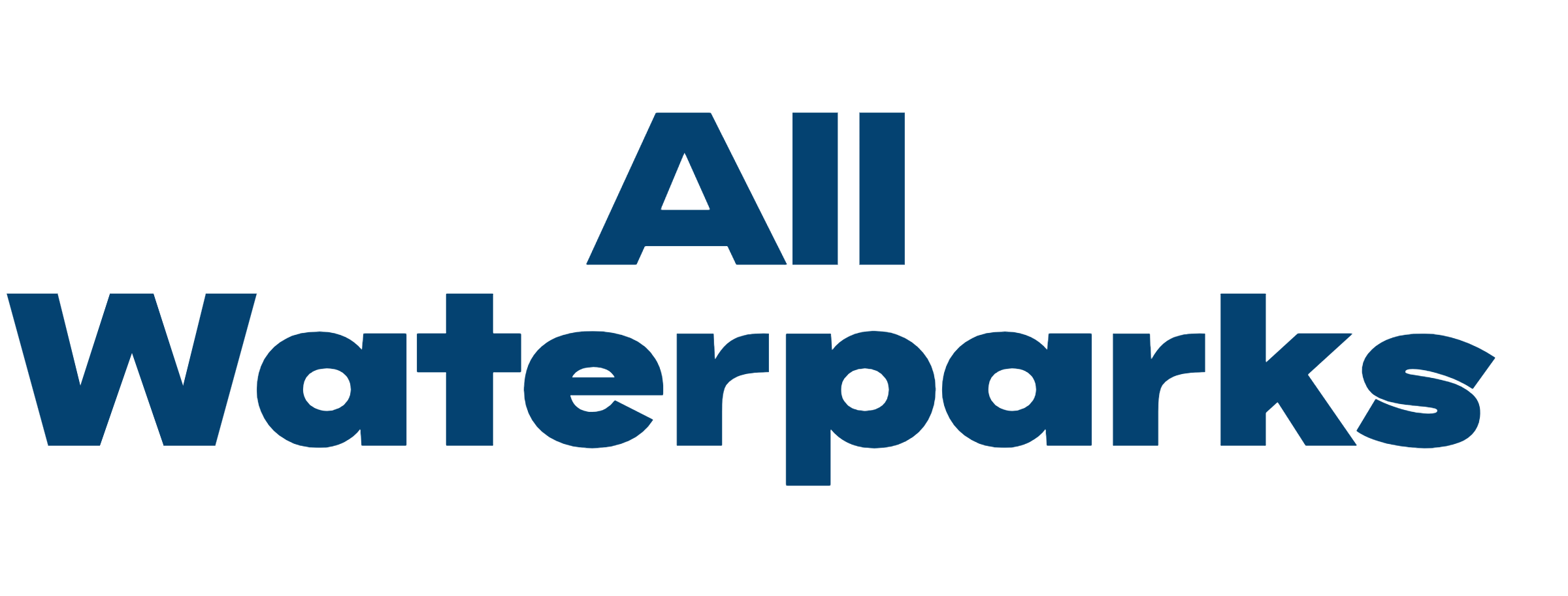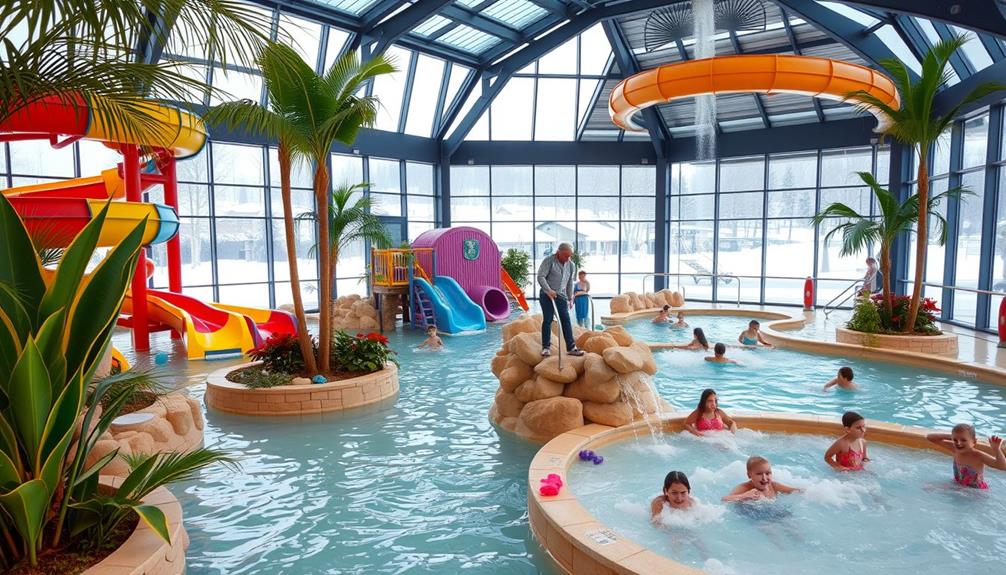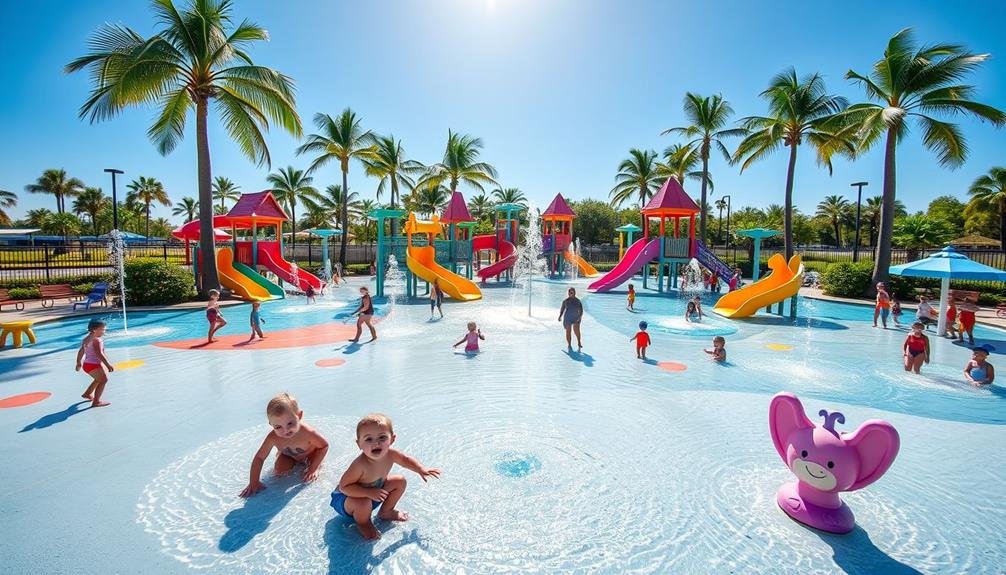Water parks play a vital role in boosting local economies by driving tourism and creating jobs. When you visit places like Great Wolf Lodge or Kalahari, you'll notice they attract many tourists year-round. These parks not only generate millions in tax revenue but also create hundreds of jobs in various sectors, from maintenance to guest services. This influx of visitors helps surrounding businesses thrive and reduces local unemployment rates. With improved infrastructure like roads and public transport, everyone benefits. There's much more to explore about how these parks shape communities economically and socially.
Key Takeaways
- Water parks significantly boost local economies by attracting year-round visitors and generating substantial tax revenue, as seen in Wisconsin Dells' $1.1 billion tax base.
- New water park projects create numerous job opportunities, with examples like Great Wolf Lodge generating 600 jobs and Kalahari's project providing 1,200 construction jobs.
- Seasonal employment opportunities, such as ride operators and lifeguards, help lower local unemployment rates and stimulate growth for surrounding businesses.
- Water parks enhance local infrastructure and transportation, improving accessibility and fostering a vibrant economic environment for tourism and community services.
- Community engagement is vital for the success of water park projects, ensuring transparency in funding and building support for long-term economic commitments.
Economic Impact Overview
Over the past few decades, water parks have emerged as vital contributors to local economies. Their economic impact extends far beyond the gates of the parks themselves. For instance, in Wisconsin Dells, the water park industry adds a staggering $1.1 billion to the tax base, greatly benefiting its 2,700 residents. This kind of revenue boosts local economies and enhances the quality of life for community members.
Additionally, many water parks, such as those in Michigan, combine thrilling rides with family-friendly environments, attracting visitors year-round and further solidifying their economic contributions through top hotels providing aquatic fun.
When new water parks open, they generate substantial job creation, as seen with the Great Wolf Lodge in Garden Grove, which is set to create 600 jobs while generating an impressive $8.5 million in annual tax revenue.
Similarly, Kalahari's massive $350 million project in the Poconos is expected to create 1,200 construction jobs and generate $18 million in tourism revenue.
These developments not only create jobs directly but also stimulate surrounding businesses, leading to increased tourism and further economic growth. As visitors flock to these attractions, local hotels and retail establishments thrive, fostering a cycle of prosperity that benefits everyone.
Ultimately, water parks play a vital role in reducing unemployment and enhancing local economies.
Job Creation Dynamics
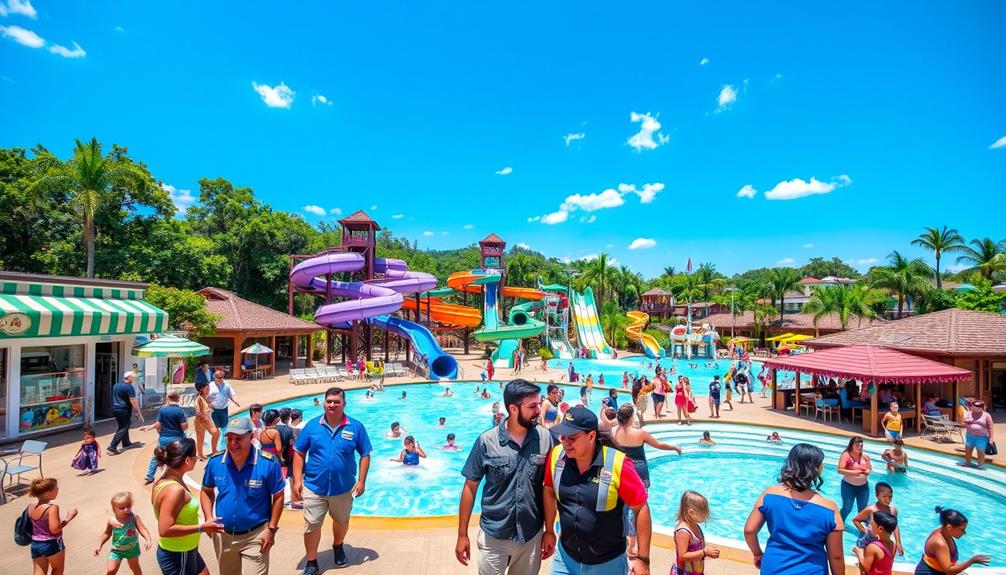
When waterparks open, they create a wealth of employment opportunities, from full-time positions to seasonal and part-time jobs. These water park career opportunities cater to a variety of skill sets, ranging from lifeguards and ride operators to administrative roles and food service staff. They not only provide individuals with a chance to earn an income but also allow them to build experience in a fun, fast-paced environment. Many who start with seasonal roles often find themselves pursuing long-term water park career opportunities as they grow within the industry.
This includes various roles in maintenance, guest services, and food and beverage operations, which are critical to the park's success.
You'll find that these establishments often hire locally, boosting the job market considerably.
This influx of jobs not only supports the waterpark but also encourages growth in nearby businesses, enhancing the overall economy.
Essential Items for a Home Cleaning Kit
Employment Opportunities Growth
Waterparks often spark significant employment growth in local economies, creating a multitude of job opportunities across various sectors. Projects like the Great Wolf Lodge and Kalahari's developments illustrate how waterparks can generate substantial employment, with the latter alone expected to create 1,200 construction jobs.
This surge in job creation not only benefits the tourism sector but also strengthens local businesses by providing direct and indirect employment opportunities. Additionally, a thriving local economy enhances community well-being, as mental health support becomes increasingly essential for residents engaged in diverse job roles.
In places like Wisconsin Dells, the waterpark industry contributes to a staggering $1.1 billion tax base, supporting local employment for its residents. The economic development driven by waterparks enhances community stability and helps decrease local unemployment rates.
Additionally, the ripple effect of waterpark success stimulates job openings in related industries, such as hospitality and retail, offering even more recreational opportunities for locals.
This growth in employment opportunities creates a vibrant local economy, allowing residents to gain valuable work experience while contributing to the community's overall prosperity. As waterparks continue to thrive, their positive impact on job creation and local businesses will remain a key component of economic development.
Seasonal and Part-time Jobs
Many waterparks create numerous seasonal and part-time job opportunities, especially during peak tourist seasons. These jobs are crucial for boosting local economies and providing employment to your community, contributing to a vibrant local atmosphere that can enhance overall tourism experiences.
For instance, the Great Wolf Lodge in Garden Grove is expected to generate around 600 jobs, illustrating the significant potential for job creation in waterpark developments. Additionally, the unique wellness offerings at these parks can attract a diverse clientele, further benefiting the local economy through increased visitor spending exclusive activities.
Here's a glimpse of the types of seasonal jobs you might find at these attractions:
- Ride operators, ensuring guests have a safe and enjoyable experience
- Maintenance staff, keeping the facilities in top shape
- Guest services, assisting visitors with inquiries and support
- Lifeguards, ensuring safety at all water attractions
- Food and beverage staff, catering to hungry thrill-seekers
The employment opportunities offered by waterparks not only lower local unemployment rates but also stimulate growth for surrounding businesses.
As seen in regions like Wisconsin Dells, the waterpark industry forms an essential part of the economic ecosystem, enhancing tourism and creating a vibrant local community. Taking advantage of these seasonal jobs can lead to valuable work experience and contribute to the thriving local economy.
Tourism Growth Factors

Tourism growth depends on various factors, and waterparks play a crucial role in attracting visitors. They serve as major tourist destinations, boosting local economies and creating numerous job opportunities. For instance, Wisconsin Dells' waterpark industry generates a staggering $1.1 billion in tax revenue for its 2,700 residents, showcasing how waterparks can greatly enhance local tourism.
Additionally, much like the influence of celebrity lifestyles on local economies through events and attractions, waterparks can create unique experiences that draw visitors from far and wide, contributing to a community's charm and appeal celebrity events.
The Great Wolf Lodge in Garden Grove is projected to attract countless tourists, generating $8.5 million in annual tax revenue and creating 600 jobs. Similarly, Kalahari's ambitious $350 million project in the Poconos is set to increase local tourism revenue by $18 million while providing 1,200 construction jobs.
These developments not only attract tourists but also stimulate the growth of additional businesses, such as hotels and retail shops, which enhance community appeal.
Moreover, increased tourism from waterparks leads to better local infrastructure and services, fostering a vibrant economic environment. By investing in waterpark attractions, communities can guarantee sustained economic growth that benefits everyone.
Fundamentally, waterparks serve as a catalyst for job creation and revenue generation, making them indispensable to local tourism strategies.
Community Engagement and Support

When planning a water park, your community's buy-in is essential; without it, the project can struggle to secure funding and support.
Engaging families through activities that enhance digital creativity can provide a platform for discussing the park's potential benefits, as these conversations help illustrate the job opportunities a water park can bring innovative workshop concepts.
You'll see that local engagement not only boosts enthusiasm but also highlights the benefits and job opportunities a water park can bring.
Plus, being transparent about funding practices helps build trust and guarantees residents feel their needs are considered.
Importance of Local Buy-In
Community buy-in is vital for the success of waterpark projects, as local enthusiasm can make or break a venture's viability. When residents feel engaged and informed, it fosters a supportive environment that can lead to significant benefits for local economies.
Additionally, involving families in recreational activities, such as importance of play, can enhance community bonds and contribute to a healthier lifestyle. Here are some key aspects to evaluate:
- Local jobs: Waterparks can create numerous employment opportunities, from construction to ongoing operations.
- Community support: Active involvement from locals can drive positive sentiment and promote project acceptance.
- Job creation: Increased employment can help alleviate financial stress for families and boost overall economic health.
- Tourism: A well-supported waterpark attracts visitors, enhancing the region's appeal and increasing revenue.
- Public engagement: Transparent communication about funding and project plans guarantees residents feel their concerns are heard.
Transparency in how tax revenues are allocated is essential, as it builds trust and encourages community support.
Community Benefits and Opportunities
Local engagement not only supports the development of water parks but also opens up a range of benefits for residents. When your community rallies behind these projects, it greatly enhances their viability and project funding.
Water parks can be powerful economic drivers, generating jobs and boosting tourism, which is crucial for your local economy. For instance, Kalahari's $350 million investment in the Poconos is expected to create 1,200 construction jobs and attract substantial tourist revenue.
Additionally, the focus on sustainable investments can lead to environmentally friendly water park designs that appeal to eco-conscious visitors and investors alike.
Community support for water parks often leads local officials to advocate for their development, especially in times of financial stress and high unemployment rates, which stood at 7.7% in February 2013.
Successful water parks can stimulate further business growth, benefiting nearby hotels and retail shops. This interconnected growth not only increases overall community appeal but also fosters greater financial stability.
Transparent Funding Practices
Recognizing the significance of transparent funding practices can considerably enhance community support for water parks. When residents understand how funding is allocated, they're more likely to embrace the project.
Transparency fosters public acceptance, which is essential for the long-term success of any water park initiative. Additionally, clear communication about the potential economic benefits, such as job creation and increased tourism, can help alleviate fears that may arise from financial concerns, similar to how effective communication techniques are imperative in steering relationships with individuals facing emotional challenges.
To illustrate this point, consider the following:
- Clear communication about funding sources and allocations builds trust within the community.
- Engaging residents in discussions can clarify the benefits of tourism and job creation.
- Transparency helps alleviate concerns about financial stress and the economic impact on local economies.
- When developers see active community support, they're more inclined to invest in the area.
- Open dialogue can lead to collaborative solutions, addressing potential challenges early on.
Financing Challenges and Solutions

Securing financing for waterpark projects often presents unique challenges that can hinder development. Since these attractions are often viewed as non-mainstream products, you might find yourself relying on alternative funding sources instead of traditional loans. Major brands, like Marriott, have turned to these methods due to increased banking regulations complicating large-scale financing.
Additionally, leveraging unique investment opportunities, such as Gold IRAs, can provide innovative funding solutions for such projects.
To attract waterpark development, economic incentives such as tax abatements and infrastructure funds are frequently offered. For example, Garden Grove's $62 million incentive package for the Great Wolf Lodge exemplifies how local governments can support these ventures.
However, public financing often hinges on tax revenue generation, which can be risky; if funding is unexpectedly withdrawn or delayed, project completion could be jeopardized.
Given the combined risks associated with financing waterparks, you'll usually need multiple lenders involved. This emphasizes the importance of collaboration with local governments to enhance project feasibility.
Public Funding Considerations
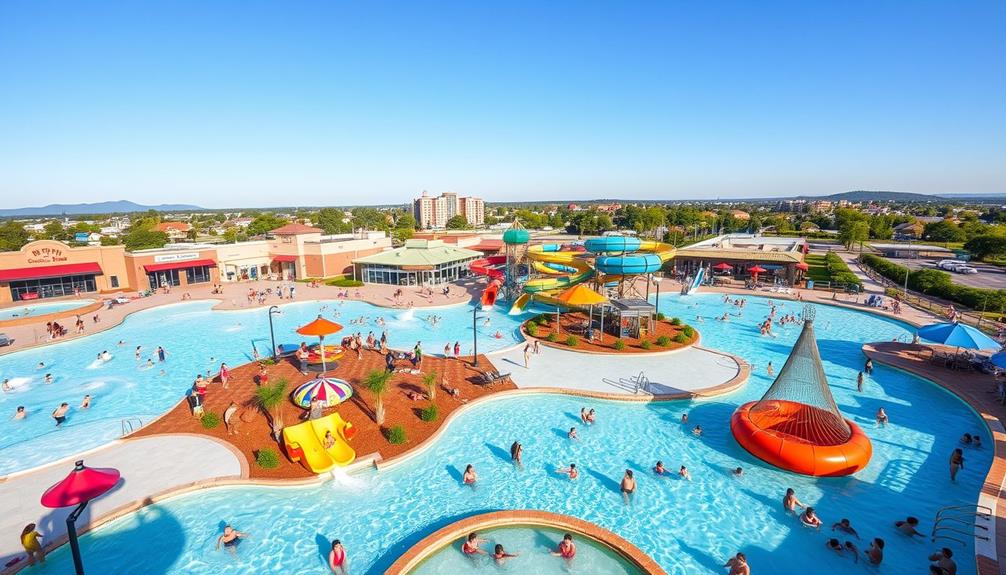
Public funding plays an essential role in the development of waterparks, often serving as a catalyst for attracting significant investment. For instance, in Garden Grove, a $62 million incentive package aimed to draw the Great Wolf Lodge, which is projected to create around 600 jobs and generate approximately $8.5 million in annual tax revenue.
However, the process isn't without its challenges.
- Delays in public financing can derail projects.
- Community opposition can arise regarding fund allocation.
- Transparency in funding is vital for public support.
- Economic incentives like tax abatements are critical yet limited.
- Long-term obligations require accountability from developers.
Municipalities often grapple with financial constraints, making it difficult to provide these economic incentives.
Furthermore, when funding arrives only after tax revenue generation, the risk of withdrawal poses threats to project viability.
You'll find that community opposition can be mitigated through effective communication and transparency about how public funding is utilized.
Ultimately, ensuring that waterpark developments align with community interests can foster a more supportive environment, leading to successful investments and job creation.
Long-Term Economic Commitments
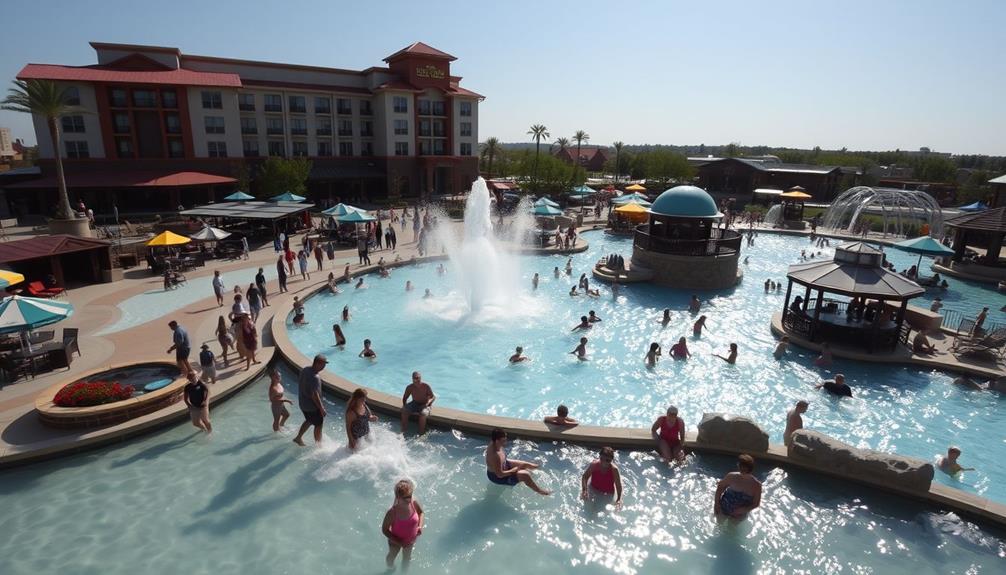
Long-term economic commitments from waterpark developers are crucial for guaranteeing their projects meet community expectations and fulfill obligations tied to public funding. These commitments not only assure adherence to local guidelines but also foster substantial economic benefits for the area.
For instance, successful projects like Kalahari's $350 million investment in the Poconos promise to create around 1,200 construction jobs and generate approximately $18 million in tourism revenue.
When developers prioritize long-term commitments, they contribute to sustained job creation, effectively lowering unemployment rates in communities that need employment opportunities. Furthermore, consistent engagement with the community guarantees transparency and accountability for the public funds utilized, solidifying ongoing support for these ventures.
The economic impact is significant, as illustrated by the $8.5 million annual tax revenue projected from Great Wolf Lodge in Garden Grove. This reinforces the critical nature of fulfilling long-term financial commitments, as these contributions directly enhance local economies.
Essentially, when waterpark developers invest in long-term economic commitments, they're not just building attractions; they're cultivating thriving communities and robust tourism economies that benefit everyone.
Infrastructure Development Contributions
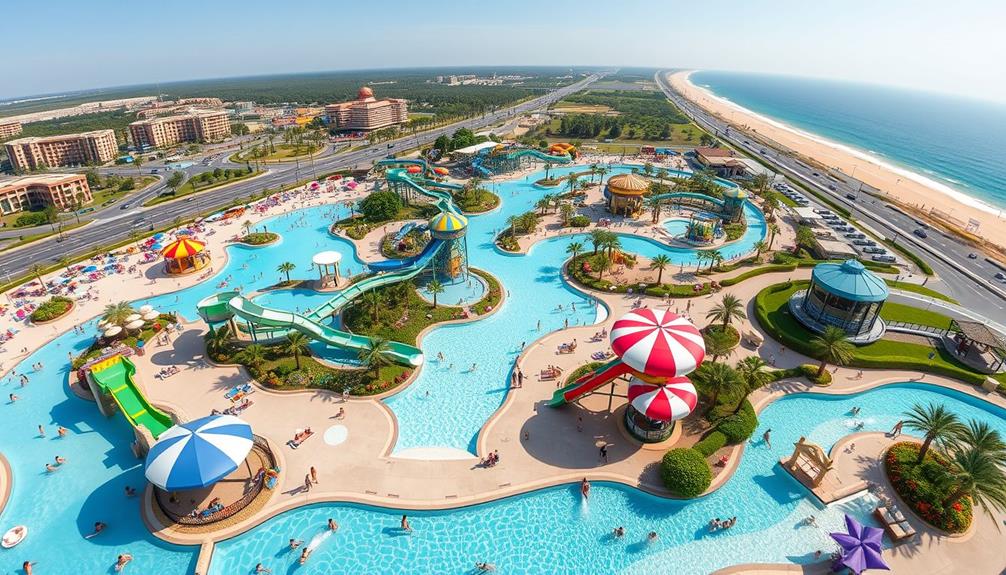
Waterparks can spark significant improvements in community infrastructure, enhancing the overall quality of life for residents.
As these attractions draw in tourists, you'll notice upgrades in transportation and accessibility that benefit everyone.
This investment not only boosts local businesses but also guarantees your community is better connected and equipped for growth.
Community Infrastructure Improvements
Infrastructure improvements often emerge as a crucial component of developing a thriving waterpark. These enhancements not only support the waterpark industry but also drive considerable benefits for local communities.
When you invest in infrastructure, you're setting the stage for increased tourism and economic growth. Here are some key aspects of these community infrastructure improvements:
- Upgraded roads that facilitate easier access to the waterpark
- Enhanced public transportation options for visitors and residents
- Improved utilities that support both the waterpark and surrounding businesses
- Increased tax base, enabling local governments to fund essential services
- Economic incentives like tax increment financing (TIF) to spur further investments
A prime example is the Kalahari's $350 million project in the Poconos, expected to stimulate extensive infrastructure investments.
Similarly, in Wisconsin Dells, the waterpark industry has notably contributed to a $1.1 billion tax base, allowing municipalities to enhance community facilities.
These improvements create a win-win situation, where local economies flourish, and residents benefit from better amenities, all thanks to the investments made in the waterpark sector.
Enhanced Transportation Accessibility
Improving transportation accessibility greatly enhances the experience for both visitors and locals, creating a more inviting atmosphere around waterpark developments.
Infrastructure improvements are essential in this regard, as they lead to upgraded transportation systems that facilitate easy access to attractions. When municipalities invest in road expansions and upgrades, they accommodate the increased traffic from waterpark tourism, benefiting surrounding businesses and communities.
Take the Great Wolf Lodge project in Garden Grove, for example. It received a $62 million incentive package that included vital infrastructure improvements, greatly boosting visitor access.
Such enhancements not only attract tourists but also stimulate further investment in public transportation options, making it easier for everyone to visit.
With improved accessibility, you'll notice reduced traffic congestion, fostering a smoother experience for all.
These developments contribute to a thriving local economy, as they encourage spending in nearby shops, restaurants, and services.
Ultimately, integrating waterparks into local economies can result in long-term benefits, supporting sustainable tourism growth and enhancing the quality of life for residents.
Seasonal Employment Opportunities

Every summer, water parks become essential sources of seasonal employment, hiring thousands of staff to meet the influx of visitors. These seasonal employment opportunities not only benefit individuals but also play an important role in boosting local economies.
For example, Great Wolf Lodge in Garden Grove is set to create around 600 jobs, greatly aiding the community's workforce. In smaller areas like Wisconsin Dells, the waterpark industry supports approximately 2,700 residents, showcasing the impact of job creation in tourism hotspots.
Some common roles in water parks include:
- Ride operators ensuring visitor safety and fun
- Lifeguards monitoring pool areas and providing assistance
- Food service staff catering to hungry guests
- Maintenance workers keeping the parks in top shape
- Guest services representatives enhancing visitor experiences
These positions typically attract a diverse range of workers, including students and part-time employees.
The jobs created during the busy season stimulate spending in nearby businesses, fostering a vibrant community atmosphere. With each lifeguard whistle and food order, water parks help weave the fabric of local economies, making summer not just a season of fun, but also a time of opportunity.
Case Studies of Success

Water parks not only provide seasonal employment but also serve as powerful engines for local economic growth. Take the Great Wolf Lodge in Garden Grove, for instance. It's projected to create 600 jobs and generate $8.5 million in annual tax revenue, highlighting the significant local economic impact of water parks.
Similarly, Kalahari's $350 million project in the Poconos is expected to create 1,200 construction jobs while generating $18 million in tourism revenue. These figures underscore the potential for job creation through water park development.
Wisconsin Dells stands as another success story, where the water park industry contributes to a $1.1 billion tax base for its 2,700 residents. This illustrates the substantial economic benefits derived from water park attractions.
You'll find that water parks stimulate additional business growth, as seen in Garden Grove, where the Great Wolf Lodge can lead to increased hotel and retail activity.
Successful projects like these demonstrate how enhanced tourism can positively affect overall community appeal and financial stability. If you consider the local economic impact, it's clear that investing in water parks can yield strong returns for communities.
Frequently Asked Questions
How Do Parks Contribute to the Economy?
Parks boost the economy by attracting visitors who spend money on local businesses. They increase property values, enhance community cohesion, and promote public health, ultimately reducing healthcare costs and creating a vibrant, thriving local environment.
How National Parks Play an Important Role in the Economy at the Local State and National Level?
National Parks play a crucial role in the economy by attracting visitors who spend money, creating jobs, and boosting local businesses. You'll see how they enhance community resilience and drive economic growth at every level.
How Do Amusement Parks Affect the Economy?
When you think of amusement parks, you're looking at a goldmine for local economies. They create jobs, boost tourism, and generate tax revenue, all while enhancing community infrastructure. It's a win-win situation for everyone involved.
What Is the Economic Impact of Recreation Development?
Recreation development boosts local economies by creating jobs, increasing tourism, and generating tax revenue. You'll see enhanced community infrastructure and business growth, leading to greater financial stability and improved quality of life for residents.
Conclusion
In the grand scheme of things, water parks aren't just places for splashes and laughter; they're vibrant engines driving local economies. By creating jobs and attracting visitors, these aquatic havens breathe life into communities. While financing can be a slippery slope, innovative solutions pave the way for sustainable growth. Embracing water parks means embracing a wave of opportunity—one that can ripple through your town for years to come. Immerse yourself and watch the benefits unfold!
